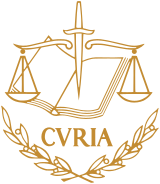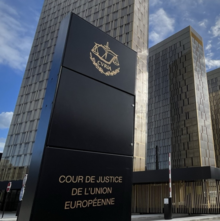
Back Hof van Justisie van die Europese Unie Afrikaans محكمة العدل للاتحاد الأوروبي Arabic Tribunal de Xusticia de la Xunión Europea AST Суд Еўрапейскага саюза Byelorussian Съд на Европейския съюз Bulgarian Lez-varn Unaniezh Europa Breton Evropski sud pravde BS Tribunal de Justícia de la Unió Europea Catalan Soudní dvůr Evropské unie Czech Llys Cyfiawnder Ewrop Welsh
 Emblem of the Court of Justice of the European Union | |
 Palais de la Cour de Justice, Luxembourg | |
| Judicial branch overview | |
|---|---|
| Formed | 1952 |
| Jurisdiction | European Union and Northern Ireland[a] |
| Headquarters | Palais de la Cour de Justice, Kirchberg, Luxembourg City, Luxembourg |
| Child agencies | |
| This article is part of a series on |
 |
|---|
|
|
The Court of Justice of the European Union (CJEU) (French: Cour de justice de l'Union européenne or "CJUE"; Latin: Curia[2]) is the judicial branch of the European Union (EU). Seated in the Kirchberg quarter of Luxembourg City, Luxembourg, this EU institution consists of two separate courts: the Court of Justice and the General Court.[3][4] From 2005 to 2016, it also contained the Civil Service Tribunal. It has a sui generis court system, meaning 'of its own kind', and is a supranational institution.[5]
The CJEU is the chief judicial authority of the EU and oversees the uniform application and interpretation of European Union law, in co-operation with the national judiciary of the member states.[4] The CJEU also resolves legal disputes between national governments and EU institutions, and may take action against EU institutions on behalf of individuals, companies or organisations whose rights have been infringed.[6]
- ^ House of Lords European Union Committee (1 June 2020). 9th Report of Session 2019–21: The Protocol on Ireland/Northern Ireland (Report). House of Lords. p. 65. Archived from the original on 31 January 2021. Retrieved 2 January 2021.
The Protocol will also confer full jurisdiction on the CJEU to oversee the operation of EU law applying to Northern Ireland in relation to customs and the movement of goods, technical regulations, VAT and excise, the Single Electricity Market and State aid; including the jurisdiction to hear applications for preliminary rulings submitted by the courts of Northern Ireland. The UK will have the right to participate in these proceedings as if it were a Member State.
- ^ "Court of Justice of the European Union". curia.europa.eu.
- ^ Article 19 TEU: The Court of Justice of the European Union shall include the Court of Justice, the General Court and specialised court.
- ^ a b Cite error: The named reference
Curia - CJEU General Presentationwas invoked but never defined (see the help page). - ^ Bordin, Fernando Lusa; Müller, Andreas Th.; Pascual-Vives, Francisco (31 August 2022). The European Union and Customary International Law. Cambridge University Press. p. 50. ISBN 978-1-108-96751-8.
- ^ "Court of Justice of the European Union (CJEU)". Europa. Retrieved 23 October 2015.
Cite error: There are <ref group=lower-alpha> tags or {{efn}} templates on this page, but the references will not show without a {{reflist|group=lower-alpha}} template or {{notelist}} template (see the help page).



